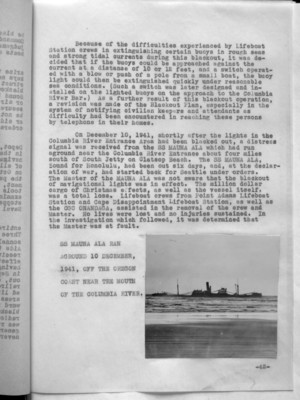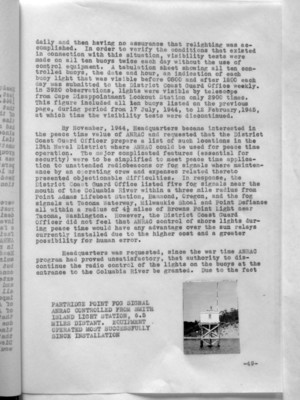Pages That Mention Point Adams Lifeboat Station
Coast Guard District narrative histories 1945
62
Because of the difficulties experienced by Lifeboat Station crews in extinguishing certain buoys in rough seas and strong tidal currents during this blackout, it was decided that if the buoys could be approached against the current at a distance of 10 or 12 feet, and a switch operated with a blow or push of a pole from a small boat, the buoy light could then be extinguished quickly under reasonable sea conditions. (Such a switch was later designed and installed on the lighted buoys on the approach to the Columbia River Bar.) As a further result of this blackout operation, a revision was made of the Blackout Plan, especially in the system of notifying civilian keepers and attendants as difficulty had been encountered in reaching these persons by telephone in their homes.
On December 10, 1941, shortly after the lights in the Columbia River Entrance Area had been blacked out, a distress signal was received from the SS MAUNA ALA which had run aground near the Columbia River Entrance about four miles south of South Jetty on Clatsop Beach. The SS MAUNA ALA, bound for Honolulu, had been out six days, and, at the declaration of war, had started back for Seattle under orders. The Master of the MAUNA ALA was not aware that the blackout of navigational lights was in effect. The million dollar cargo of Christmas effects, as well as the vessel itself, was a total loss. Lifeboat crews from Point Adams Lifeboat Station and Cape Disappointment Lifeboat Station, as well as the CGC ONANDAGA, assisted in the removal of the crew and Master. No lives were lost and no injuries sustained. In the investigation which followed, it was determined that the Master was at fault.
SS MAUNA ALA RAN AGROUND 10 DECEMBER, 1941, OFF THE OREGON COAST NEAR THE MOUTH OF THE COLUMBIA RIVER.
(image)
-42-
69
daily and then having no assurance that relighting was accomplished. In order to verify the conditions that existed in connection with this situation, visibility tests were made on all ten buoys twice each day without the use of control equipment. A tabulation sheet showing all ten controlled buoys, the date and hour, an indication of each buoy light that was visible before 0800 and after 1200 each day was submitted to the District Coast Guard Office weekly. In 3920 observations, lights were visible by telescope from Cape Disappointment Lookout Station only 2900 times. This figure included all ten buoys listed on the previous page, during period from 17 July, 1944, to 12 February, 1945, at which time the visibility tests were discontinued.
By November, 1944, Headquarters became interested in the peace time value of ANRAC and requested that the District Coast Guard Officer prepare a list of such locations in the 13th Naval District where ANRAC could be used for peace time operation. The major complicated features (essential for security) were to be simplified to meet peace time application to unattended radiobeacons or fog signals where maintenance by an operating crew and expenses related thereto presented objectionable difficulties. In response, the District Coast Guard Office listed five fog signals near the mouth of the Columbia River within a three mile radius from Point Adams Lifeboat Station, Hammond, Oregon, and the fog signals at Tacoma Waterway, Milwaukie Shoal and Point Defiance all within a radius of 4 1/2 miles of Browns Point Light near Tacoma, Washington. However, the District Coast Guard Officer did not feel that ANRAC control of shore lights during peace time would have any advantage over the sun relays currently installed due to the higher cost and a greater possibility for human error.
Headquarters was requested, since the war time ANRAC program had proved unsatisfactory, that authority to discontinue the radio control of the lights on the buoys at the entrance to the Columbia River be granted. Due to the fact
(image)
PARTRIDGE POINT FOG SIGNAL ANRAC CONTROLLED FROM SMITH ISLAND LIGHT STATION, 6.5 MILES DISTANT. EQUIPMENT OPERATED MOST SUCCESSFULLY SINCE INSTALLATION
-49-

